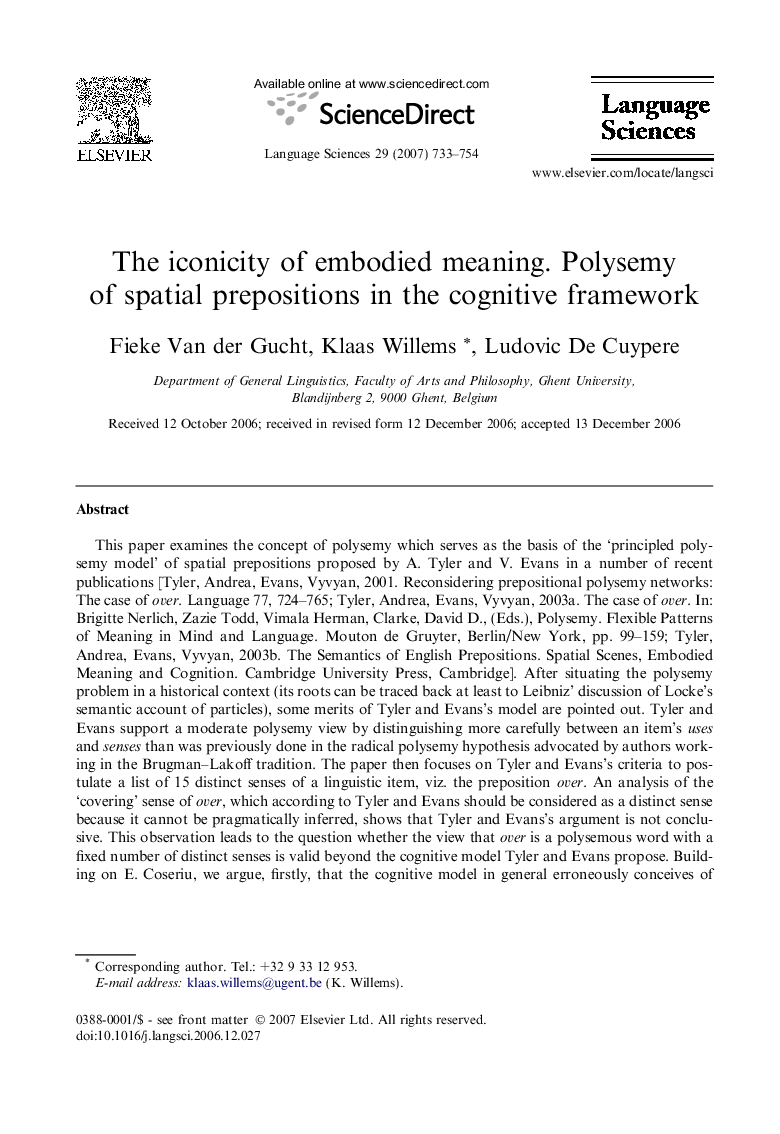| کد مقاله | کد نشریه | سال انتشار | مقاله انگلیسی | نسخه تمام متن |
|---|---|---|---|---|
| 1103713 | 953767 | 2007 | 22 صفحه PDF | دانلود رایگان |

This paper examines the concept of polysemy which serves as the basis of the ‘principled polysemy model’ of spatial prepositions proposed by A. Tyler and V. Evans in a number of recent publications [Tyler, Andrea, Evans, Vyvyan, 2001. Reconsidering prepositional polysemy networks: The case of over. Language 77, 724–765; Tyler, Andrea, Evans, Vyvyan, 2003a. The case of over. In: Brigitte Nerlich, Zazie Todd, Vimala Herman, Clarke, David D., (Eds.), Polysemy. Flexible Patterns of Meaning in Mind and Language. Mouton de Gruyter, Berlin/New York, pp. 99–159; Tyler, Andrea, Evans, Vyvyan, 2003b. The Semantics of English Prepositions. Spatial Scenes, Embodied Meaning and Cognition. Cambridge University Press, Cambridge]. After situating the polysemy problem in a historical context (its roots can be traced back at least to Leibniz’ discussion of Locke’s semantic account of particles), some merits of Tyler and Evans’s model are pointed out. Tyler and Evans support a moderate polysemy view by distinguishing more carefully between an item’s uses and senses than was previously done in the radical polysemy hypothesis advocated by authors working in the Brugman–Lakoff tradition. The paper then focuses on Tyler and Evans’s criteria to postulate a list of 15 distinct senses of a linguistic item, viz. the preposition over. An analysis of the ‘covering’ sense of over, which according to Tyler and Evans should be considered as a distinct sense because it cannot be pragmatically inferred, shows that Tyler and Evans’s argument is not conclusive. This observation leads to the question whether the view that over is a polysemous word with a fixed number of distinct senses is valid beyond the cognitive model Tyler and Evans propose. Building on E. Coseriu, we argue, firstly, that the cognitive model in general erroneously conceives of prepositional meanings in terms of lexical rather than instrumental meanings, and that the alleged distinct senses of the preposition over Tyler and Evans postulate are in fact utterance meanings of entire phrases and clauses; this explains the still high number of distinct senses attributed to the prepositional item. Secondly, we attempt to illustrate that the main reason why a battery of senses is postulated in the first place derives from a non-linguistic criterion we term the ‘iconicity of embodied meaning’. This criterion prompts the linguist to accept as many distinct senses as there are prototypical common sense experiences commonly associated with (or, ‘reflected by’) the use of a specific linguistic item in various instantiations.
Journal: Language Sciences - Volume 29, Issue 6, November 2007, Pages 733–754